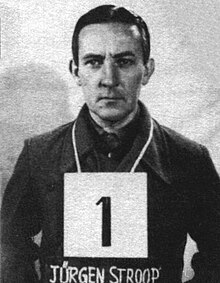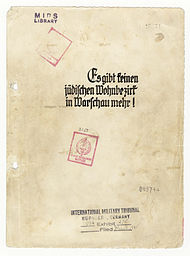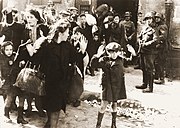| Revision as of 10:38, 24 July 2013 editKingstowngalway (talk | contribs)Extended confirmed users21,911 edits →The Warsaw Ghetto, transfer to Greece and return to Germany← Previous edit | Revision as of 10:39, 24 July 2013 edit undoKingstowngalway (talk | contribs)Extended confirmed users21,911 editsNo edit summaryNext edit → | ||
| Line 150: | Line 150: | ||
| ] | ] | ||
| ] | ] | ||
| ] | |||
| ] | ] | ||
| ] | ] | ||
Revision as of 10:39, 24 July 2013
| Jürgen Stroop | |
|---|---|
 Jürgen Stroop in U.S. military custody, 1945 Jürgen Stroop in U.S. military custody, 1945 | |
| Born | (1895-09-24)24 September 1895 Detmold, Germany |
| Died | 6 March 1952(1952-03-06) (aged 56) Warsaw, Poland |
| Allegiance | |
| Service | |
| Rank | Feldwebel SS-Gruppenführer und Generalleutnant der Waffen-SS und Polizei SS- und Polizeiführer |
| Battles / wars | World War I World War II (Warsaw Ghetto) |
Jürgen Stroop, (born Josef Stroop, 26 September 1895 in Detmold, Germany — died 6 March 1952 in Warsaw, Poland), was a high-ranking Nazi Party and SS official during World War II. He was best known for his role in liquidating the Warsaw Ghetto and for his book-length account of the operation: a document originally titled The Warsaw Ghetto Is No More. Following Germany's defeat, Stroop was sentenced to death for war crimes by a US military tribunal during the Dachau Trials in 1947. He was later extradited to Poland where he was also tried and convicted of crimes against humanity. He was hanged by Polish authorities in 1952.
Early life
Jürgen Stroop was born in Detmold, in the Principality of Lippe, in the German Empire, the son of a police officer. In conversation with Kazimierz Moczarski, Stroop recalled being subjected to physical abuse by his father. He further recalled that his mother was far more devoutly Roman Catholic than his father. Both of his parents were enthusiastic monarchists. The elder Stroop often expressed hope that his son would also loyally serve Leopold IV, Prince of Lippe.
After receiving an elementary education, he became an apprentice with the land register in Detmold, where he worked until the outbreak of World War I. He joined the Imperial German Army in 1914 as a volunteer, served in several infantry regiments at the Western Front. Stroop was awarded the Iron Cross 2nd Class and was wounded in action. Stroop subsequently served on the Eastern Front and in Romania. At the end of the war, he held the rank of a vice-Feldwebel (Sergeant). After the Armistice, Stroop returned to work at the land register, while remaining active in a veterans' organization.
During the 1920s, Stroop embraced Germanic neo-paganism under the influence of General Erich von Ludendorff and his wife Mathilde. He later recalled that Mathilde Ludendorff, "revealed the truth about the Catholic Church in Germany and returned us to the true Germanic gods. By recalling the pure, pre-Germanic ways, she pointed out the rottenness of the Judeo-Christian ethic and showed how the organized Church had been strangling the Reich for twelve hundred years." Stroop further recalled, "It was thanks to what I was lucky enough to learn from her books that I was able to rid myself of religious prejudice and mark Gottgläubig in the column concerning belief." In another conversation with Moczarski, Stroop called Catholicism, "a catch-all of religions, infected with Judaism." He further claimed that Christianity was created as a Jewish conspiracy to, "enslave the world through guilt."
SS career
Stroop joined the NSDAP and SS in 1932. In 1933, he was appointed leader of the state auxiliary police. One year later, he was promoted from the rank of SS-Oberscharführer to the rank of SS-Hauptsturmführer. Subsequently he worked for the SS administration in Münster and Hamburg. In the autumn of 1938, he was promoted again, this time to the rank of SS-Standartenführer (colonel) and served in the Sudetenland. After the invasion of Poland, he served as commander of the SS-section in Gnesen (Gniezno). During the occupation of Poland, Stroop was transferred to Poznan as head of Selbstschutz, the notorious "self-defense" formation of the local ethnic Germans.
In May 1941, Stroop changed his name from Josef to Jürgen for ideological reasons and in honor of his deceased son. From 7 July to 15 September 1941, Stroop served in combat on the eastern front with the infantry regiment of the 3rd SS Division Totenkopf. He was awarded a Clasp to the Iron Cross 2nd Class and an Infantry Assault Badge in Bronze. On 16 September 1942, he was promoted to SS-Brigadeführer and assigned as an Inspector of the SiPo and SD of the Higher SS and Police Leader for Russia South. In this position Stroop worked to help secure a key logistical route for German forces on the Eastern Front. Beginning in October 1942, Stroop commanded an SS garrison at Kherson, before becoming the SS and Police Leader (SSPF) for Lemberg (Lviv) in February 1943.
The Warsaw Ghetto, transfer to Greece and return to Germany

Stroop's most historically prominent role was the suppression of the Warsaw Ghetto Uprising, an action which cost the lives of over 50,000 people. He was sent to Warsaw on 17 April 1943 by Heinrich Himmler, as a replacement for SS-Oberführer Ferdinand von Sammern-Frankenegg, who was relieved of duty. Stroop took over from Sammern-Frankenegg following the latter's failure to suppress the uprising at the onset:
I had two battalions of Waffen-SS, one hundred army men, units of Order Police, and seventy-five to a hundred Security Police people. The Security Police had been active in the Warsaw ghetto for some time, and during this program it was their function to accompany SS units in groups of six or eight, as guides and experts in ghetto matters.

Stroop had recently been involved in operations against Soviet partisans in Ukraine and was familiar with the latest German counter-insurgency tactics. He ordered the entire ghetto to be systematically burned down and blown up building by building. All of the survivors, including men, women, and children were either killed on the spot of deported to extermination camps. After the uprising was suppressed, he prepared a detailed record of the operation, a 75-page report, bound in black leather and including copies of all communiqués sent to SS Police Leader East Friedrich-Wilhelm Kruger and photographs. Originally titled "The Jewish Quarter of Warsaw is no more!", it is commonly referred to as "The Stroop Report" and would later be used as evidence at the Nuremberg Trials. Stroop then formally assumed the position of SS and Police Leader of Warsaw. Kruger presented an Iron Cross 1st Class to him on 18 June 1943 for the Warsaw Ghetto "action" at a gala reception in Warsaw’s Lazienki Park.
Stroop was subsequently named the Higher SS and Police Leader (HSSPF) in Greece on 8 September 1943. The local civilian administration found his methods and behaviour unacceptable and withdrew cooperation, forbidding the local Order Police from having anything to do with him, which made his position untenable. Consequently, he was removed and on 9 November was appointed Commander of SS-Oberabschnitt Rhein-Westmark (an SS administrative district named for the Rhine and Gau Westmark) in Wiesbaden, serving there until the close of the war.
Trials and execution


In early May 1945, Stroop was captured by American forces in the town of Rottau in Bavaria. Wearing the uniform of an infantry officer, he bore false discharge papers made out to a Wehrmacht Captain of Reserve Josef Straub. He kept to this story for nearly two months, before admitting to being Jürgen Stroop on 2 July.
He was then put on trial by the U.S. Military Tribunal at Dachau (Dachau Trials) for the summary executions of Allied airmen (Fliegermorde), shot down over Germany in his field of command. On 21 March 1947, he was sentenced to death by the tribunal. However, that sentence was not carried out; instead, he was extradited for trial in the People's Republic of Poland.
While awaiting trial in Warsaw's Mokotów Prison, Stroop was placed in the same cell with Kazimierz Moczarski, a former member of Poland's anti-Nazi Armia Krajowa. Following the Red Army's installation of a communist puppet government in Poland, Moczarski had been jailed by the Ministry of Public Security, spending four years on death row.
In conversation with Moczarski, Stroop opened up in detail about his life. He also gleefully recalled his involvement in the destruction of Warsaw's Great Synagogue:
"What a wonderful sight! I called out, Heil Hitler! and pressed the button. A terrific explosion brought flames right up to the clouds. The colors were unbelievable. An unforgettable allegory of the triumph over Jewry."
Stroop also informed Moczarski of what he considered the real reasons for the Third Reich's collapse. He said, "We lost the war for one reason only! The plotting of internationalist factions. The Communists, Socialists, Jews, Reactionaries, Anglo-Saxons, Freemasons, and Catholic elements tore our nation apart. What's more, the Reich could never have been defeated without the help of traitors like Canaris, Goerdeler, Stauffenberg, Thalmann, Schumacher, Niemöller, Kluge, Paulus, Pieck, and scum like that Norwegian Willy Brandt. History proves that we were too liberal, Herr Moczarski. We should have muzzled those scoundrels more tightly."
On November 11, 1949, Stroop and Moczarski were separated by prison authorities. Knowing that they would never meet again, Stroop reminded Moczarski that it was Poland's independence day and the thirty-first anniversary of the German Empire's defeat in World War I. Before their final parting, the two former enemies shook hands.
On 23 July 1951, after a trial lasting three days, a Polish court sentenced Stroop and Franz Konrad to death by hanging. Stroop was hanged on 6 March 1952, outside the Mokotow prison in Warsaw.
Legacy
After his release in 1956, Moczarski wrote a memoir about his imprisonment with Stroop, titled Rozmowy z katem (Conversations with an Executioner). Portions of the book appeared in newspapers and magazines in parts while Moczarski was still alive. The entire manuscript was not published in its complete form until after Moczarski's death, posthumously published in 1977. An English translation was released in 1981. Conversations with an Executioner has since been translated into several languages, including Hebrew for readers in the State of Israel.
In popular culture
- In the 1976 film The Eagle Has Landed, Jürgen Stroop is portrayed by the German actor Joachim Hansen (the character is simply referred to as "Herr Gruppenführer" and not by Stroop's actual name, although in the source novel by Jack Higgins, Stroop's name is used).
- In the 2001 film Uprising, Stroop is depicted as the film's main antagonist and is portrayed by the American actor Jon Voight.
- In the 2006 Polish television film Rozmowy z katem (Conversations with an Executioner), based on Kazimierz Moczarski's memoir, Stroop is played by the actor Piotr Fronczewski.
Quote
- "How could they consider harming their Fuehrer? Adolf Hitler was placed on earth by a higher power, perhaps Wotan himself, to fulfill a sacred mission. The July conspiracy was an example of the moral decay that proved to be our undoing. It would have been impossible to defeat Germany without German participation, Herr Moczarski. If it hadn't been for negligence disguised as tolerance, we could have held off the whole world. Instead, we allowed degenerate forces to pollute our healthy masses. A few weaklings poisoned by enemy agents and infected with subversive ideologies were all it took to undermine us. The minute we suffered military defeats, the cancerous elements in our society swung into action, organizing Mafias and creating 'patriotic discussion groups.' In the end, they destroyed our nation."
References
- Kazimierz Moczarski, Conversations with an Executioner, pages 33–34.
- ^ Moshe Arens, Who Defended The Warsaw Ghetto? (The Jerusalem Post)
- Jurgen Stroop Diary, including The Stroop Report: Table of Contents (Jewish Virtual Library)
- Jewish Virtual Library, Ferdinand von Sammern-Frankenegg Source: Danny Dor (Ed.), Brave and Desperate. Israel Ghetto Fighters, 2003, p. 166.
- "Statement by Stroop to Investigators About His Actions in the Warsaw Ghetto". Jewishvirtuallibrary.org. 1946-02-24. Retrieved 2012-05-04.
- "Axis History Factbook: SS-Oberabschnitt Rhein-Westmark". Axishistory.com. Retrieved 2012-05-25.
- "Nazi Crimes on Trial: The Dachau Trials". .jur.uva.nl. Retrieved 2012-05-04.
- Kazimierz Moczarski, Conversations with an Executioner, Prentice-Hall, 1981. Page 45.
- Kazimierz Moczarski: Gespräche mit dem Henker. Das Leben des SS-Generals Jürgen Stroop. Aufgezeichnet im Mokotów-Gefängnis zu Warschau. Osburg, Berlin 2008
- Conversations with an Executioner, page 220.
Further reading
- Friedman, Towiah (1986). The Trial Against SS-general Jürgen Stroop in Warsaw, Poland. Institute of Documentation in Israel for the Investigation of Nazi War Crimes.
{{cite book}}: Cite has empty unknown parameter:|coauthors=(help) - Moczarski, Kazimierz (1981). Conversations With an Executioner. Prentice-Hall. ISBN 0-13-171918-1.
{{cite book}}: Unknown parameter|coauthors=ignored (|author=suggested) (help) - Stroop, Jürgen (1979). The Stroop Report: The Jewish Quarter of Warsaw Is No More!. Pantheon Books. ISBN 0-394-50443-7.
{{cite book}}: Cite has empty unknown parameter:|coauthors=(help)
Bibliography
- Kazimierz Moczarski "Conversations with an Executioner" Prentice-Hall 1981, ISBN 0-13-171918-1
- Joachim Jahns: Der Warschauer Ghettokönig. Dingsda-Verlag, Leipzig 2009, ISBN 978-3-928498-99-9.
External links
See also
Categories:- 1895 births
- 1952 deaths
- Adherents of Germanic neopaganism
- Anti-Catholicism in Germany
- Anti-Christianity
- Anti-Masonry
- People from Detmold
- Former Roman Catholics
- German anti-communists
- German military personnel of World War I
- German murderers
- German murderers of children
- German neopagans
- German police officers convicted of murder
- Greece in World War II
- Holocaust perpetrators
- Nazis executed in Poland
- Nazis convicted of war crimes
- People convicted in the Dachau Trials
- People from North Rhine-Westphalia executed by hanging
- People from the Principality of Lippe
- Police misconduct in Germany
- Police misconduct in Greece
- Prisoners sentenced to death by the United States military
- SS and Police Leaders
- SS generals
- The Holocaust in Greece
- The Holocaust in Poland
- Warsaw Ghetto
- People extradited to Poland
- People executed by Poland by hanging
- Anti-Catholic politicians
- Police officers executed for murder